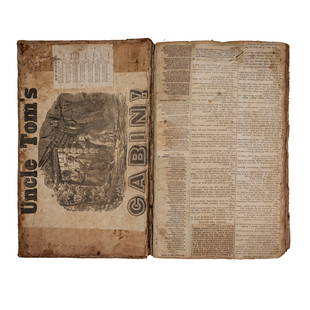

 Discovery- InteriorsBonhamsSponsored.Your ad here?
Discovery- InteriorsBonhamsSponsored.Your ad here?



Discovery- Interiors
Bonhams
Sponsored.Your ad here?


 Discovery- InteriorsBonhamsSponsored.Your ad here?
Discovery- InteriorsBonhamsSponsored.Your ad here?



Discovery- Interiors
Bonhams
Sponsored.Your ad here?

Three cuttings from a large Carolingian Theological
Similar Sale History
View More Items in Books, Magazines & PapersRelated Books, Magazines & Papers
More Items in Books, Magazines & Papers
View MoreRecommended Collectibles
View More


Item Details
Description
Three cuttings from a large Carolingian Theological Compendium , with a decorated geometric and animal initial, in Latin, manuscript on parchment [most probably France, ninth century (probably first half)] Three long and thin strips, cut vertically from 2 leaves for reuse as gathering supports in later bindings, 2 of them fitting together to make a fragment of 295 by 105mm., with an initial I (opening In principio erat verbum … , the beginning of the Gospel of John), two-thirds of the height of the fragment, formed from split bands with sections of geometric interlace, enclosing compartments of similar decoration on red grounds, and terminating in foliage and two tiny facing animal heads which hold sprigs of leaves in their mouths, the foot of the initial shaded with red to lift it visually from the page, 6 lines of capitals shaded in red introducing and opening the text, and overall 22 lines of a fine and rotund Carolingian minuscule using the et-ligature integrally within words, a tall s at the end of lines, an e with a long and thin tongue, a long r which extends far below the baseline and a squat t whose cross bar sits at the top of its ascender and occasionally extends beyond the body of the character, other text titles in simple capitals, plus another similarly sized strip from the same parent codex, with remnants of 25 lines in same, 287 by 59mm., slight cockling and scuffing, and with small paper remnants adhered to edges, but overall in good condition Provenance: These fragments were recovered from the seventeenth-century French bindings of a printed set of Gerson s Opera , once in the library of the Jesuits of Grenoble. Text: Few Biblical quotations sum up the spirit of rediscovery and rebirth of Christian Europe under Charlemagne as the opening of John s Gospel. The last years of the eighth century and the beginning of the ninth, saw a new principio or beginning for Christian learning in which the manuscripts of the Gospels were studied, refined, corrected and copied again in imposing and elegant codices for distribution across the Empire. The parent codex of the present cuttings brought together theological readings, most probably for reading aloud and contemplation in a religious community. Here the Gospel of John sits alongside a Psalm Commentary by the scholarly titan of the late Antique world, Cassiodorus (c.485-c.585). He served both Theodoric the Goth and his successor Athanaric as the new barbarian masters of Rome, and in the establishment of a contemplative scholarly community at his estate of Vivarium, set the model for virtually all monastic communities to come. To these the third cutting adds the fundamental philosophical bedrock of the Homilies of St. Augustine of Hippo (354-430). It is worth reflecting on the fact that when these lines were written, the works of these two late Antique writers were only between two and four centuries old, and thus this witness is closer to their age, than ours, by at least three times. The Initial: The form of the initial here suggests a West Frankish (ie. French) origin, with the short compartment of interlace work set on black in the upper part of its body being found in books from that region (see the Gallican Psalter of c. 800, now BnF. latin 13159; Trésors Carolingiens , 2007, no. 26) as well as the stylised leaves used to fill the compartment in the lower part of the initial (see the Gospel Book made c . 830 in the Paris region, now BnF. latin 11959; Trésors Carolingiens , no. 30). Close parallels exist in French books for the two facing dog-headed lacertine creatures in a fragment of a ninth-century Sacramentary (now Vienna, ÖNB, Theol. C.992; reproduced in H.J. Hermann, Die frühmittelalterlichen Handschriften des Abendlandes , 1923, pl. xxxvi), and the Arsenal Gospels (BnF., Arsenal ms. 592; Trésors Carolingiens , p. 208), as well as the single-lines stalks terminating in leaves similar to those they hold in their mouths in a copy of Sulpicius Severus, Epistola ad Aurelium (Vienna, ÖNB, Cod. 468; ibid., fig. 41). However, the complex and fluttering form of the acanthus-leaf foot of the initial has more in common with Rhineland models (compare the Bible, now Cologne, Dombibl. MS Dom 1; Évangélaires Carolingiens Enluminés , 1990, fig. 38, and Glaube und Wissen im Mittelalter , 1998, no. 25, p. 162), and the artist may have worked in a centre in the north east of modern France. The delicate red penwork shading and use of red wash to create the impression of the foot of the initial lifting from the page is harder to find elsewhere, and may be the artist s own technique. Few comparable Carolingian leaves with any form of complex initial have appeared on the market in the last few decades. The most recent was a large initial F on a damaged leaf from a Lectionary, made in the more abstract style of the second half of the ninth century, which appeared in the Schøyen sale at Sotheby s, 10 July 2012, lot 33, realising £18,000 hammer.
Buyer's Premium
- 29% up to £150,000.00
- 23% above £150,000.00
Three cuttings from a large Carolingian Theological
Estimate £8,000 - £12,000
5 bidders are watching this item.
Shipping & Pickup Options
Item located in Mayfair, London, ukSee Policy for Shipping
Payment

TOP











































































![George Washington Signed Discharge: Partly printed discharge document signed by George Washington, as Commander in Chief of the Armies of the United States. Newburgh, [New York], 4 January 1783. 1 page, ## x ## in. Undersigned by Washin](https://p1.liveauctioneers.com/7226/322253/173251475_1_x.jpg?height=310&quality=70&version=1710004847)

